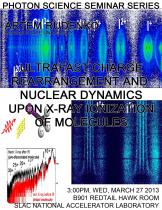Artem Rudenko, Kansas State University
Charge and energy transfer reactions are among the most important photo-induced processes in physics, chemistry and biology, with practical applications ranging from artificial photosynthesis and molecular electronics to preventing corrosion in materials. Some of the cleanest microscopic examples of these reactions are represented by inter-atomic relaxation processes in core-shell ionized molecular or cluster systems, such as molecular Auger, interatomic Coulombic or electron-transfer mediated decays. However, manifestations of these inter-atomic phenomena in strongly bound molecules are typically non-distinguishable from the contributions of (often dominant) intra-atomic channels.
Free-electron lasers (FEL) like LCLS delivering intense and ultrashort X-ray pulses offer unique opportunities to study basic charge and energy transfer mechanisms in fragmenting molecular systems [1]. X-ray inner-shell photoabsorption typically results in a sequence of electronic relaxation processes involving both, inner-shell and valence electrons. In the molecular environment the induced positive charge, initially localized on the absorbing atom, is later redistributed over the whole molecular system. Electronic relaxation involving delocalized valence electrons, nuclear dissociation dynamics and multiple photoabsorption often proceed on the same time scale (a few femtoseconds), resulting in a variety of interweaved fragmentation pathways.
I will review a series of recent LCLS, FLASH, and SACLA experiments employing coincident ion-momentum imaging for the visualization of charge rearrangement processes in dissociating molecules [2]. The main goal of these studies is to link our understanding of an individual atom response to intense, ultrafast X-rays [3] with the behaviour of extended polyatomic and nano-scale systems, and to clarify the role of a molecular environment in X-ray ionization. In particular, charge redistribution mechanisms, relation between intra- and inrer-atomic processes and their dependence on the internuclear distance are addressed in different experimental configurations (using single FEL pulse or employing optical laser/FEL and FEL/FEL pump-probe arrangements).
[1] J. Ullrich, A. Rudenko and R. Moshammer, Annu. Rev. Phys. Chem. 63, 635 (2012).
[2] B. Erk et al., Phys. Rev. Lett. 110, 053003 (2013).
[3] B. Rudek et al., Nature Photonics 6, 858 (2012).





